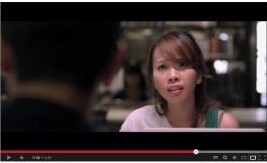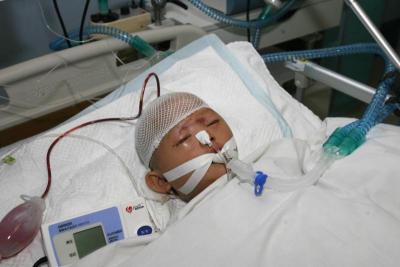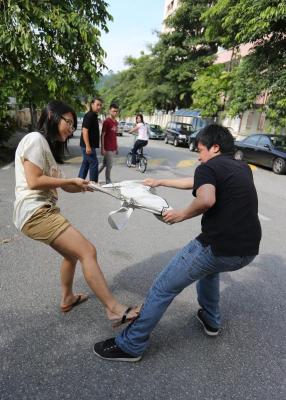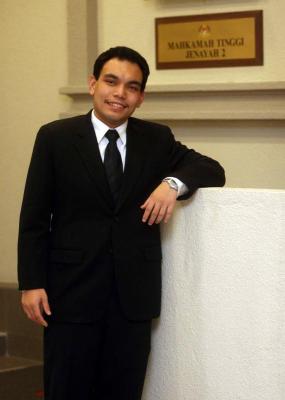By CHRISTINE CHEAH
alltherage@thestar.com.my
TRICK question: you’re in the middle of a crowded street, and you notice some guy lying on the ground motionless. Everybody seems to be walking past him. What would you do?
It’s a trick question because we already know what the answer would most likely be, thanks to this phenomenon in psychology called “diffusion of responsibility”, also known as the “bystander effect”.
Studies have shown that the more people there are in a crowd, the less likely they are to feel “responsible” to help someone in distress.
Musician Bryan Chin, 27, had to help a woman out of a burning car after a highway accident, while others either drove by or started taking photos and videos on their smartphones.
“We were the only ones who helped,” said Chin. “Quite a few cars stopped by the side of the road, but they didn’t come forward to help.”
He found out later that someone even took a video of the incident – without offering any help – and posted it on YouTube.
“I did it because I’ve been in an accident before, so I know how it feels when you’re in trouble and no one helps.”
There have been countless examples of this phenomenon occurring around the world; high profile cases that have shocked the public, who perceive it as a deterioration of our basic human instinct to help one another.
But what about Malaysian youth? Are we guilty of abdicating our responsibility towards those in need, simply because we assume, as always, someone else will do it?
Malaysian diffusion
A DIFFUSION of responsibility case made the news in Malaysia a few months ago. An Indonesian worker had suffered a stroke and collapsed at a food court which serviced mostly students from Taylor’s University Lakeside Campus in Subang Jaya, Selangor.
It was over four hours before a group of patrons – the organising committee of a debate tournament being held at the university – approached her and called for an ambulance.
Activist Juana Jaafar, who was part of the group that helped the stricken woman, said: “The woman was actually foaming at the mouth. It was very obvious she needed medical attention.”
Malaysian Crime Prevention Foundation vice-chairman Tan Sri Lee Lam Thye believes that young Malaysians now are less likely to help in the event of an emergency or crime.
“They would rather tweet about the emergency. It’s a very disturbing trend,” he said. “Based on my experience, the older generation, even if they are less tech-savvy, are more willing to help.”
According to psychologist Alex Lui, the impulse to empathise with and help a person in distress has, in a way, been numbed by technology.
Lui believes the compulsion to capture and upload everything on social media stems from the need to feel liked.
“Even the button on Facebook says ‘Like’, right?” added Lui. “So when something shocking happens, something dramatic, you want to upload it because the chances of it being ‘Liked’ are higher. It boosts our self-esteem.”
Naturally, fear plays a major role as well in diffusion of responsibility, and Lui believes fear has grown considerably in recent years.
“Now you have all these stories about con men, people being kidnapped by hitchhikers and things like that. They really affect how we respond to such situations.”
Nevertheless, Lui believes it is unfair to say diffusion of responsibility is more likely to happen to the youth of today. They might tweet about accidents, but back in the day many would take down numbers for lottery tickets too!
“Diffusion of responsibility theory was established several decades ago. People have always been this way,” said Lui.
DSP Abdul Aziz Baba, district head of the Petaling Jaya police Crime Investigation Unit, warned people to be careful when deciding to help someone in distress.
There are other factors to consider. For example, what happens if you exacerbate the condition of someone suffering from a medical problem? There are no Good Samaritan laws in Malaysia to protect you should something go wrong.
“You should always call emergency services first. You should only take action if the person’s life is in immediate danger,” said Abdul Aziz.
Local perspective
FILMMAKER Adam Sinclair, 29, released a short film about diffusion of responsibility in November last year called Sanzaru, which depicts a group of college students discussing the theory and exploring the mindset of people in those situations.
“You can argue that young Malaysians are less responsible now, but I believe the theory applies to everyone, all over the world. That’s just the way people are – you will assume someone else will help when there are more people around,” he said.
Sinclair decided to produce the short film after a friend’s fiancé was kidnapped. He had previously learned about diffusion of responsibility theory from a friend, and being concerned with the number of crime cases affecting those around him, he decided to remind people about the importance of looking out for one another.
“I wanted to educate people about it (diffusion of responsibility). We can all be like that. We can switch off, and think that someone else will help,” he said.
The response to the film so far, has been telling. It has been viewed over 70,000 times on YouTube in just six months, and it won the best short film award at the 2013 Malaysia Film Festival.
“A lot of people said it was an eye-opener. Some said they felt guilty; and I’ve been guilty of it as well! I’ve ignored some people who looked like they needed help, and I didn’t want people to make the same mistakes I did. That was the goal of the film – to make people aware about this,” he added.
Case files
THE DIFFUSION of responsibility theory was raised as early as 1964 after theKitty Genovese case in New York, the United States. Since then, the phenomenon has been noticed in several other criminal cases.
Kitty Genovese
In 1964, New Yorker Kitty Genovese was stabbed and raped over a 30-minute period in the hallway of her apartment building. Though reports vary greatly, it is believed that up to 38 people had witnessed parts of the attack, and yet nothing was done.
The tragedy prompted research into diffusion of responsibility and the “bystander effect”, leading to our current understanding on how humans react in such situations. The phenomenon is also referred to as “Genovese syndrome”.
The Steubenville rape case
In August 2012, two high school football players in Steubenville, Ohio, US, raped and sexually assaulted a drunk, unconscious teenage girl during a party. More than a dozen people at the party had taken photos and videos of the incident (including the assailants) and shared them on social media; and yet during the six hours when the victim was being abused, no one made a police report. Both students have been convicted for the rape of a minor.
Wang Yue
In a case that prompted much soul-searching in China, two-year-old Wang Yue was ran over by two vehicles on a narrow road in Foshan, Guangdong. CCTV footage captured the entire incident, showing at least 18 people walking by while Wang bled on the street. After seven minutes, a female rubbish scavenger stopped to help Wang, who was rushed to hospital. She succumbed to her injuries eight days later.
The Richmond High School gang rape
On the night of October 27, 2009, a 15-year-old female student was gang raped by a group of young males in a school courtyard with as many 20 witnesses believed to have been aware of the attack. A witness even described in court the exact details of the crime and yet no one called 911 for over two hours.
Tan Kim Chuan
Seven people were caught on CCTV walking by as 60-year-old Tan lay unconscious in a parking lot in Penang. A snatch theft had left her with a cracked skull, and it was more than six minutes before someone came to her aid. She died nine hours later in the hospital.
The Holocaust
Diffusion of responsibility is also often applied to war crimes, with the Holocaust one of the common examples. Over six million lives were lost, while German citizens feigned ignorance and Nazi officers claimed they were simply following orders.
How to help
SO you’ve resolved to never succumb to the “bystander effect”. Good for you. But jumping into helping a random stranger in distress isn’t as simple as that.
For instance, what happens if you make things worse? Malaysia doesn’t have any Good Samaritan laws. These laws exist in certain countries to encourage bystanders to offer assistance in emergencies, by protecting them in the event of unintended injuries or death during the course of a rescue.
Malaysian Medical Association president Dr. N.K.S. Tharmaseelan said when encountering an injured victim, one should always seek help from a qualified medical professional. The only things you should do is apply pressure if there is profuse bleeding, or administer CPR if there is difficulty in breathing.
In terms of criminal activity, DSP Abdul Aziz Baba, district head of the police’s Petaling Jaya Crime Investigation Unit, said Malaysians are even allowed to perform citizen’s arrests on perpetrators, but only with extreme caution.
“If the crime you are witnessing is endangering others, you may go ahead and perform a citizen’s arrest,” he said. “But the first thing you should think of is your personal safety. If you believe it could cause harm to yourself or anyone else, do not intervene.”
Civil liberties lawyer Syahredzan Johan added that if the person in distress has already received assistance, then it mighthelp to film the process.
“There was a case where we won because the people around filmed the incident and presented it as evidence to the court.
“I would encourage people to film the entire process but with not with the intention of sharing it on social media,” said Syahredzan, who added that any visuals of the process should be kept confidential for the benefit of the author and people involved.
Damsel in distress
JUST how many people came to help me as I pretended to be in distress for our cover photo shoot at the Kuala Lumpur Railway Station?
There must have been at least 150 people who walked by, in a shoot that lasted almost two hours. Some were ambling by, some were scrambling through the crowds.
At the point when I felt all hope for humanity was lost, lying there “in pain” on a bench, two ladies came up. They were your typical makcik-next-door, carrying some bulky suitcases.
“Adik pengsan ke? Ok tak? (Did you faint? Are you alright?)” asked one of the makcik.
My colleague Kevin immediately came out to assure them I was totally fine and just posing for a photo.
“Oh, nasib baik. Ingat apa-apa terjadi… (Oh, that’s good. I thought something happened).” They smiled and carried on with their journey.
Thank you, dear makcik, for restoring my faith in humanity. In the hustle and bustle of the city, there were still caring Malaysians that found the time to care for someone, even if those were only two.











Tell us what you think!